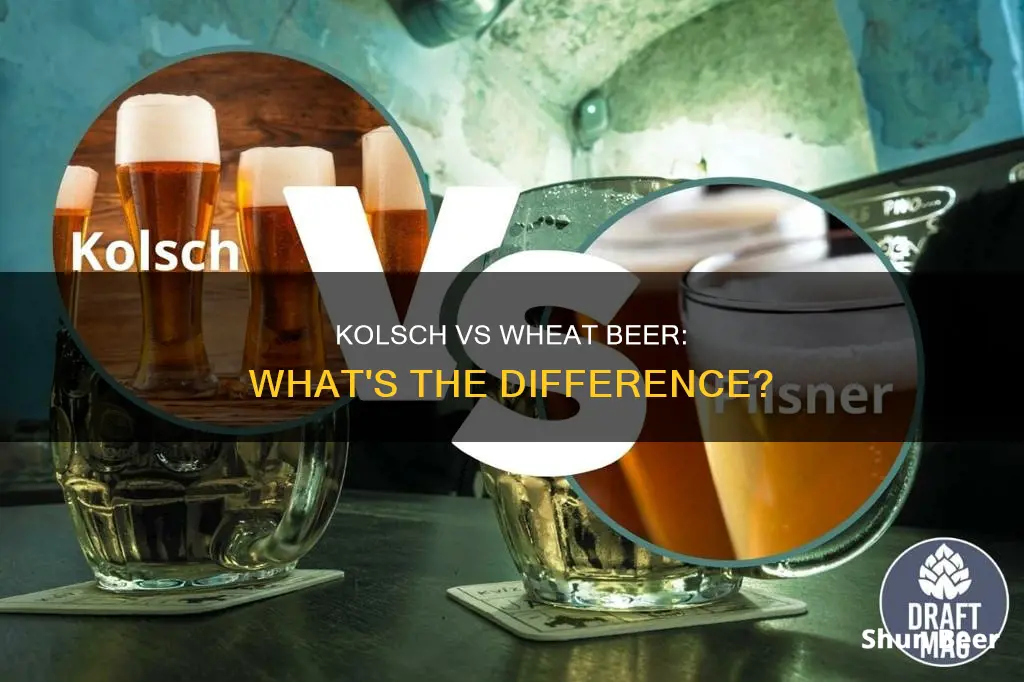
Wheat beer and Kölsch are distinct styles of beer with different appearances, flavour profiles, and mouthfeels. Wheat beers are brewed with a significant portion of wheat malt, while Kölsch is primarily brewed with Pilsner malt, a barley-based malt. Wheat beers tend to have a hazy appearance due to the presence of wheat proteins and yeast, while Kölsch is a clear, pale gold beer with a slight effervescence and a foamy white head. In terms of flavour, wheat beers have a robust profile with bready or doughy flavours, while Kölsch has a crisp, clean flavour with a slightly sweet malt backbone. The mouthfeel of wheat beer is creamier and fuller due to the higher protein content in wheat malt, while Kölsch has a light to medium body with a smooth and refreshing mouthfeel.
| Characteristics | Values |
|---|---|
| Origin | Kolsch: Cologne, Germany; Wheat Beer: Germany |
| Brewing Process | Kolsch: Top-fermenting process, cold-conditioned like a lager; Wheat Beer: Bottom-fermenting process |
| Appearance | Kolsch: Clear, pale gold with a slight effervescence and a foamy white head; Wheat Beer: Hazy |
| Aroma | Kolsch: Delicate, subtle fruity notes and a hint of hoppy spiciness; Wheat Beer: Pronounced aroma with strong notes of banana, clove, and sometimes even bubblegum |
| Flavor | Kolsch: Crisp, clean flavor with a slightly sweet malt backbone and a subtle hop bitterness; Wheat Beer: Robust flavor profile with a bready or doughy flavor |
| Body | Kolsch: Light to medium body with a smooth and refreshing mouthfeel; Wheat Beer: Creamier, fuller mouthfeel due to higher protein content |
What You'll Learn

Geographical origin
Wheat beer and Kölsch differ in their geographical origins, among other characteristics.
Wheat beer has two main varieties: German Weizenbier and Belgian witbier. Weizenbier, or Hefeweizen, was introduced to Bavaria in the 15th century from neighbouring Bohemia. In 1548, William IV, Duke of Bavaria, granted the right to brew and sell wheat beer to Baron Hans VI von Degenberg. By law, Weizenbiers brewed in Germany must use a "top-fermenting" yeast. Belgian witbiers, on the other hand, are often made with raw unmalted wheat and are brewed mainly in Belgium and the Netherlands.
Kölsch, on the other hand, is a style of beer that originated in Cologne (Köln), Germany. The term "Kölsch" has had a protected geographical indication (PGI) within the European Union since 1997, indicating that it is made within 50 km of Cologne and brewed according to the Kölsch Konvention. The Kölsch Konvention is a set of strict rules that dictate the brewing process, ingredients, and geographical origin of the beer. The name "Kölsch" comes from the German city of Köln (Cologne) and is protected by law. Only beer brewed in and around Köln can be called Kölsch.
Leffe: A Wheat Beer or Not?
You may want to see also

Brewing process
The brewing process for Kölsch differs from that of wheat beer, although there are some similarities.
Kölsch is a German ale that originated in Cologne and is brewed using a top-fermenting process. It is then cold-conditioned like a lager, resulting in a hybrid brewing process that combines the characteristics of both ale and lager brewing. This process gives Kölsch its unique taste and flavour profile.
Wheat beers, such as Hefeweizen and Witbier, also use a top-fermenting process. However, the primary difference lies in the grains used for brewing. Kölsch is brewed primarily with Pilsner malt, which is a barley-based malt, while wheat beers are brewed with a significant proportion of wheat malt.
The appearance of the two beers also differs. Kölsch is a clear, pale gold beer with a slight effervescence and a foamy white head. Wheat beers tend to have a hazy appearance due to the presence of wheat proteins and yeast, which remain suspended in the beer.
The aroma of a Kölsch is delicate, with subtle fruity notes and a hint of hoppy spiciness. Wheat beers have a more pronounced aroma, often with strong notes of banana, clove, and sometimes even bubblegum, depending on the yeast used.
Kölsch has a crisp, clean flavour with a slightly sweet malt backbone and subtle hop bitterness. Wheat beers have a more robust flavour profile, with the wheat malt adding a bready or doughy taste, and the yeast contributing characteristic banana and clove notes.
Kölsch is known for its light to medium body and a smooth, refreshing mouthfeel. Wheat beers tend to have a creamier, fuller mouthfeel due to the higher protein content in the wheat malt, resulting in a more substantial body.
Spaten Oktoberfest: Wheat Beer or Not?
You may want to see also

Appearance
When it comes to appearance, there are several differences between a Kölsch and a wheat beer. Kölsch is a clear, pale gold beer with a slight effervescence and a foamy white head. In contrast, wheat beers tend to have a hazy or cloudy appearance due to the presence of wheat proteins and yeast, which remain suspended in the beer.
Kölsch beers typically have a straw-yellow to pale golden colour, with a white head. This is similar to pilsners, which also have a straw yellow to pale golden appearance. However, the head on a pilsner is often described as "snowy" rather than white.
The clarity of a Kölsch is showcased by the tall and narrow glass in which it is traditionally served, known as a "stange" (meaning "rod" or "stick" in German). The stange holds just 200 millilitres (6.8 to 7 US fluid ounces) of beer, ensuring that the Kölsch is always served chilled and fresh, with maximum sparkle.
Wheat beers, on the other hand, are often served in a wheat beer glass, which is typically shorter and wider than a stange. This type of glass highlights the beer's hazy appearance and can showcase the beer's carbonation and head retention.
PBR: Wheat Beer or Not?
You may want to see also

Aroma
When it comes to aroma, there are distinct differences between a Kölsch and a wheat beer.
Kölsch is a German ale with a light gold colour and a mildly fruity profile. It has a delicate aroma with subtle fruity notes and a hint of hoppy spiciness. The fruity notes are a result of the beer being fermented at warm temperatures. The hops used in the brewing process also contribute to the aroma of a Kölsch. German noble hops or similar varieties such as Perle are used to give it a floral aroma. Newer varieties with citrus or fruity characters should be avoided as they can overpower the delicate balance of the beer. The overall aroma of a Kölsch is described as elegantly aromatic, with mellow scents of honeysuckle, grass, earthy herbs, and lemon zest.
On the other hand, wheat beers have a more pronounced aroma. They often have strong notes of banana and clove, and sometimes even bubblegum, depending on the yeast strain used in brewing. Wheat beers tend to showcase a more robust aroma due to the presence of wheat proteins and yeast, which remain suspended in the beer.
While both Kölsch and wheat beers have some similarities in their aromas, the main difference lies in the intensity and specific notes present. Kölsch has a more delicate and subtle aroma, while wheat beers are more robust and pronounced.
Exploring Bock and Wheat Beer Differences
You may want to see also

Mouthfeel
Kölsch is a style of beer that originated in Cologne, Germany. It is a hybrid beer, combining the top-fermenting process typical of ales with the cold-conditioning process of lagers. This results in a light and smooth mouthfeel, with a crisp, dry finish. The use of Pilsner malt, which is made from barley, gives Kölsch a clean and refreshing quality. The mouthfeel of Kölsch is often described as light to medium-bodied, with a subtle hop bitterness and a slightly sweet malt backbone.
On the other hand, wheat beers tend to have a fuller and creamier mouthfeel due to the presence of wheat malt. Wheat proteins and yeast remain suspended in the beer, creating a hazy appearance and contributing to a more substantial body. The wheat malt adds a bready or doughy flavor to wheat beers, while the yeast produces characteristic banana and clove notes.
The mouthfeel of these two styles of beer can be summarised as follows: Kölsch has a light and smooth mouthfeel with a crisp finish, while wheat beers offer a fuller and creamier sensation on the palate.
Wheat Beers: Heavy, Bitter, or Both?
You may want to see also
Frequently asked questions
Kölsch is a German ale that combines the best elements of a lager and an ale. It is a refreshing style of beer that stands out for its drinkability and exceptional balance of malt and fruit flavours.
Wheat beers are brewed with a significant portion of wheat malt, which gives them a hazy appearance due to the presence of wheat proteins and yeast. They have a more robust flavour profile, with the wheat malt adding a bready or doughy flavour.
The primary difference between kölsch and wheat beer is in the grains used for brewing. Kölsch is brewed primarily with pilsner malt (barley), while wheat beers are brewed with wheat malt. Kölsch is clear and pale gold, while wheat beers are often hazy.
Both kölsch and wheat beer share some similarities in aroma and brewing techniques. They are also top-fermented beers.







